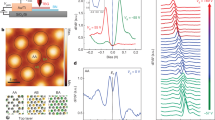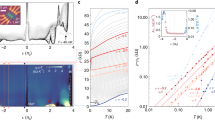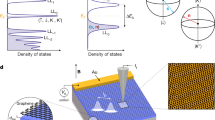Abstract
Bilayer graphene is an attractive platform for studying new two-dimensional electron physics1,2,3,4,5, because its flat energy bands are sensitive to out-of-plane electric fields and these bands magnify electron–electron interaction effects. Theory6,7,8,9,10,11,12,13,14,15,16 predicts a variety of interesting broken symmetry states when the electron density is at the carrier neutrality point, and some of these states are characterized by spontaneous mass gaps, which lead to insulating behaviour. These proposed gaps6,7,10 are analogous17,18 to the masses generated by broken symmetries in particle physics, and they give rise to large Berry phase effects8,19 accompanied by spontaneous quantum Hall effects7,8,9,20. Although recent experiments21,22,23,24,25 have provided evidence for strong electronic correlations near the charge neutrality point, the presence of gaps remains controversial. Here, we report transport measurements in ultraclean double-gated bilayer graphene and use source–drain bias as a spectroscopic tool to resolve a gap of ∼2 meV at the charge neutrality point. The gap can be closed by a perpendicular electric field of strength ∼15 mV nm−1, but it increases monotonically with magnetic field, with an apparent particle–hole asymmetry above the gap. These data represent the first spectroscopic mapping of the ground states in bilayer graphene in the presence of both electric and magnetic fields.
This is a preview of subscription content, access via your institution
Access options
Subscribe to this journal
Receive 12 print issues and online access
$259.00 per year
only $21.58 per issue
Buy this article
- Purchase on Springer Link
- Instant access to full article PDF
Prices may be subject to local taxes which are calculated during checkout




Similar content being viewed by others
References
Zhang, Y. B., Tan, Y. W., Stormer, H. L. & Kim, P. Experimental observation of the quantum Hall effect and Berry's phase in graphene. Nature 438, 201–204 (2005).
Novoselov, K. S. et al. Two-dimensional gas of massless Dirac fermions in graphene. Nature 438, 197–200 (2005).
Novoselov, K. S. et al. Electric field effect in atomically thin carbon films. Science 306, 666–669 (2004).
McCann, E. & Fal'ko, V. I. Landau-level degeneracy and quantum Hall effect in a graphite bilayer. Phys. Rev. Lett. 96, 086805 (2006).
Castro Neto, A. H., Guinea, F., Peres, N. M. R., Novoselov, K. S. & Geim, A. K. The electronic properties of graphene. Rev. Mod. Phys. 81, 109–162 (2009).
Min, H., Borghi, G., Polini, M. & MacDonald, A. H. Pseudospin magnetism in graphene. Phys. Rev. B 77, 041407 (2008).
Nandkishore, R. & Levitov, L. Quantum anomalous Hall state in bilayer graphene. Phys. Rev. B 82, 115124 (2010).
Zhang, F., Jung, J., Fiete, G. A., Niu, Q. A. & MacDonald, A. H. Spontaneous quantum Hall states in chirally stacked few-layer graphene systems. Phys. Rev. Lett. 106, 156801 (2011).
Jung, J., Zhang, F. & MacDonald, A. H. Lattice theory of pseudospin ferromagnetism in bilayer graphene: competing interaction-induced quantum Hall states. Phys. Rev. B 83, 115408 (2011).
Zhang, F., Min, H., Polini, M. & MacDonald, A. H. Spontaneous inversion symmetry breaking in graphene bilayers. Phys. Rev. B 81, 041402 (R) (2010).
Lemonik, Y., Aleiner, I. L., Toke, C. & Fal'ko, V. I. Spontaneous symmetry breaking and Lifshitz transition in bilayer graphene. Phys. Rev. B 82, 201408 (2010).
Vafek, O. & Yang, K. Many-body instability of Coulomb interacting bilayer graphene: renormalization group approach. Phys. Rev. B 81, 041401 (2010).
Castro, E. V., Peres, N. M. R., Stauber, T. & Silva, N. A. P. Low-density ferromagnetism in biased bilayer graphene. Phys. Rev. Lett. 100, 186803 (2008).
Martin, I., Blanter, Y. M. & Morpurgo, A. F. Topological confinement in bilayer graphene. Phys. Rev. Lett. 100, 036804 (2008).
Kharitonov, M. Canted antiferromagnetic phase of the ν = 0 quantum Hall state in bilayer graphene. Preprint at arXiv:1105.5386v1101 (2011).
Zhang, F. & MacDonald, A. H. Distinguishing spontaneous quantum Hall states in graphene bilayers. Preprint at arXiv:1107.4727v1101 (2011).
Gorbar, E. V., Gusynin, V. P. & Miransky, V. A. Dynamics and phase diagram of the ν = 0 quantum Hall state in bilayer graphene. Phys. Rev. B 81, 155451 (2010).
Herbut, I. F., Juricic, V. & Vafek, O. Relativistic Mott criticality in graphene. Phys. Rev. B 80, 075432 (2009).
Xiao, D., Chang, M. C. & Niu, Q. Berry phase effects on electronic properties. Rev. Mod. Phys. 82, 1959–2007 (2010).
Vafek, O. Interacting fermions on the honeycomb bilayer: from weak to strong coupling. Phys. Rev. B 82, 205106 (2010).
Martin, J., Feldman, B. E., Weitz, R. T., Allen, M. T. & Yacoby, A. Local compressibility measurements of correlated states in suspended bilayer graphene. Phys. Rev. Lett. 105, 256806 (2010).
Weitz, R. T., Allen, M. T., Feldman, B. E., Martin, J. & Yacoby, A. Broken-symmetry states in doubly gated suspended bilayer graphene. Science 330, 812–816 (2010).
Bao, W. et al. Stacking-dependent band gap and quantum transport in trilayer graphene. Nature Phys. 7, 948–952 (2011).
Freitag, F., Trbovic, J., Weiss, M. & Schonenberger, C. Spontaneously gapped ground state in suspended bilayer graphene. Preprint at arXiv:1104.3816vs (2011).
Mayorov, A. S. et al. Interaction-driven spectrum reconstruction in bilayer graphene. Science 333, 860–863 (2011).
Min, H. K., Sahu, B., Banerjee, S. K. & MacDonald, A. H. Ab initio theory of gate induced gaps in graphene bilayers. Phys. Rev. B 75, 155115 (2007).
Ohta, T., Bostwick, A., Seyller, T., Horn, K. & Rotenberg, E. Controlling the electronic structure of bilayer graphene. Science 313, 951–954 (2006).
Barlas, Y., Cote, R., Nomura, K. & MacDonald, A. H. Intra-Landau-level cyclotron resonance in bilayer graphene. Phys. Rev. Lett. 101, 097601 (2008).
Zhao, Y., Cadden-Zimansky, P., Jiang, Z. & Kim, P. Symmetry breaking in the zero-energy Landau level in bilayer graphene. Phys. Rev. Lett. 104, 066801 (2010).
Feldman, B. E., Martin, J. & Yacoby, A. Broken-symmetry states and divergent resistance in suspended bilayer graphene. Phys. Status Solidi B 5, 889–893 (2009).
Bao, W. et al. Magnetoconductance oscillations and evidence for fractional quantum Hall states in suspended bilayer and trilayer graphene. Phys. Rev. Lett. 105, 246601 (2010).
Mucha-Kruczynski, M., Aleiner, I. L. & Fal'ko, V. I. Strained bilayer graphene: band structure topology and Landau level spectrum. Phys. Rev. B 84, 041404(R) (2011).
Haldane, F. D. M. Model for a quantum Hall-effect without landau-levels—condensed-matter realization of the parity anomaly. Phys. Rev. Lett. 61, 2015–2018 (1988).
Nagaosa, N., Sinova, J., Onoda, S., MacDonald, A. H. & Ong, N. P. Anomalous Hall effect. Rev. Mod. Phys. 82, 1539–1592 (2010).
Kane, C. L. & Mele, E. J. Quantum spin Hall effect in graphene. Phys. Rev. Lett. 95, 226801 (2005).
Konig, M. et al. Quantum spin Hall insulator state in HgTe quantum wells. Science 318, 766–770 (2007).
Raghu, S., Qi, X. L., Honerkamp, C. & Zhang, S. C. Topological Mott insulators. Phys. Rev. Lett. 100, 156401 (2008).
Henriksen, E. A. et al. Cyclotron resonance in bilayer graphene. Phys. Rev. Lett. 100, 087403 (2008).
Castro, E. V., Peres, N. M. R. & dos Santos, J. M. B. L. Gaped graphene bilayer: disorder and magnetic field effects. Phys. Stat. Sol. B 244, 2311–2316 (2007).
Borghi, G., Polini, M., Asgari, R. & MacDonald, A. H. Fermi velocity enhancement in monolayer and bilayer graphene. Solid State Commun. 149, 1117–1122 (2009).
Acknowledgements
The authors thank R. Nandkishore, B. Feldman, A. Yacoby, L. Levitov, P. Jarillo-Herrero and K. Novoselov for stimulating discussions, and D. Humphrey, G. Liu, A. Zhao and H. Zhang for assistance with fabrication. This work was supported in part by the UC LabFees programme, NSF CAREER DMR/0748910, NSF/1106358, ONR N00014-09-1-0724, ONR/DMEA H94003-10-2-1003 and the FENA Focus Center. D.S. acknowledges support from NHMFL UCGP #5068. Part of this work was performed at NHMFL, which is supported by NSF/DMR-0654118, the State of Florida, and DOE. A.M., J. J. and F.Z. acknowledge support from the Welch Foundation (grant TBF1473), NRI-SWAN and DOE (grant DE-FG03-02ER45958). C.V. acknowledges support from NSF DMR-0906530. V.A. acknowledges support from UCR I.C.
Author information
Authors and Affiliations
Contributions
C.N.L and J.V. conceived the experiments. Y.J. and P.K. isolated and identified the graphene sheets. R.S. assisted with sample preparation. J.V., L.J., W.B., Y.J. and D.S. performed transport measurements. C.N.L, M.B., W.B. and J.V. interpreted and analysed the data. V.A., C.V., F.Z., J.J. and A.H.M. interpreted data and performed theoretical calculations. C.N.L., J.V., F.Z., J.J. and A.H.M. co-wrote the paper. All authors discussed the results and commented on the manuscript.
Corresponding author
Ethics declarations
Competing interests
The authors declare no competing financial interests.
Supplementary information
Supplementary information
Supplementary information (PDF 2944 kb)
Rights and permissions
About this article
Cite this article
Velasco, J., Jing, L., Bao, W. et al. Transport spectroscopy of symmetry-broken insulating states in bilayer graphene. Nature Nanotech 7, 156–160 (2012). https://doi.org/10.1038/nnano.2011.251
Received:
Accepted:
Published:
Issue Date:
DOI: https://doi.org/10.1038/nnano.2011.251
This article is cited by
-
Spontaneous broken-symmetry insulator and metals in tetralayer rhombohedral graphene
Nature Nanotechnology (2024)
-
Ferroelectric and spontaneous quantum Hall states in intrinsic rhombohedral trilayer graphene
Nature Physics (2024)
-
Correlated insulator and Chern insulators in pentalayer rhombohedral-stacked graphene
Nature Nanotechnology (2024)
-
Orbital multiferroicity in pentalayer rhombohedral graphene
Nature (2023)
-
Reproducibility in the fabrication and physics of moiré materials
Nature (2022)



